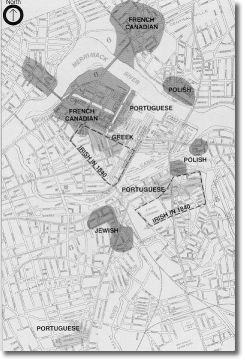Part of a series of articles titled Lowell, Story of an Industrial City.
Article
Lowell, Story of an Industrial City: Immigrant Communities

National Park Service
A 1912 map of Lowell shows five major immigrant communities scattered in clusters around the city. Little Canada, which bordered the Northern Canal, had become the primary neighborhood for French Canadians. Greeks concentrated in the Acre along Market Street, while Poles, Portuguese, and Russian Jews had their own enclave within each of these areas, ethnic institutions evolved that catered to the needs of the immigrant group. Ethnic churches were the foremost of these, with a French-Canadian Catholic Church and a Greek Orthodox Church, among others, serving their communities. Parochial schools passed on the native tongue and insured that the American-born generation did not stray too far from the ways of the homeland. Adults also had their cultural institutions: Greek coffee houses and French-Canadian social clubs contributed to the cosmopolitan air of pre-World War I Lowell.
---
From: Dublin, Thomas. 1992. Lowell: the story of an industrial city: a guide to Lowell National Historical Park and Lowell Heritage State Park, Lowell, Massachusetts. Washington, D.C.: Division of Publications, National Park Service, U.S. Department of the Interior.
Last updated: June 15, 2018
